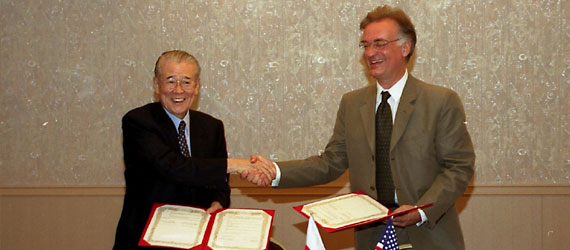
Hirayama Ikuo, former president of the Tokyo National University of Fine Arts and Music (left), and Julian Raby, director of the Freer and Sackler Galleries, sign an Agreement of International Cooperation between both institutions in July 2002.
Hirayama Program for Japanese Painting Conservation
Introduction
Hirayama Ikuo
A survivor of the bombing at Hiroshima, Hirayama Ikuo (1930–2009) achieved renown as one of Japan's most important artists of the twentieth century. Deeply aware of the importance of world culture and history, he was a philanthropist committed to the preservation of world heritage and, in particular, to Buddhist culture and historic monuments that were also the focus of his art. In 1988, he established the World Cultural Heritage Foundation. Hirayama served as the head of the Tokyo National University of Art and Music from 1989–95 and 2001–2005. His many honors and awards included the Legion d'honneur, the James Smithson award, and induction into the Order of Cultural Merit, Japan's highest honor for achievement in the arts and sciences.
History of the Program
Hirayama proposed that the Japanese government and private organizations should undertake a project to assist in the care and preservation of Japanese art in Western collections. This led to the establishment of the Joint Council for the Conservation and Restoration of Ancient Japanese Art Works in Foreign Collections in 1991.That same year, the council signed an agreement with the Freer and Sackler Galleries to provide aid for the conservation of Japanese paintings in the Galleries' collections. Over the following six years, approximately forty paintings from the Freer Gallery were conserved in Japan thanks to this support.
Following the success of this collaboration, Hirayama and the Freer and Sackler Galleries reached an agreement that created the Hirayama Program for Japanese Painting Conservation in 1999. It also endowed the program with a gift from the Foundation for Cultural Heritage and Art Research, over which Hirayama presided.
Goals of the Program
The Hirayama Program is dedicated to advancing the state of conservation of Japanese paintings in the United States. The program has four main areas of activity:
- training Western candidates in the methods and principles of Japanese painting conservation
- supporting ongoing professional exchanges between the Freer and Sackler Galleries and conservation and research organizations in Japan
- conducting lectures and workshops on the care of Japanese paintings for staff of American museums that have East Asian painting collections but no specialists in this field
- conducting lectures and workshops on the physical nature and preservation of Japanese paintings to augment university courses and educational programs in East Asian art history.
Program Activities
Conservation Training: Hirayama Fellowship in Japanese Painting Conservation
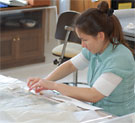
Courtney Shimoda, Hirayama Fellow since 2009, is now training at the Conservation Center for Cultural Properties in Kyoto, Japan.
The program provides financial support for the long-term commitment required of a fellow to undergo this training. The fellowship is a one-year renewable contract. Viable candidates are typically post-graduates with experience in conservation and/or studio art; a demonstrated interest in Japanese art, history, and culture; and a deep commitment to pursuing a career in Japanese painting conservation. Japanese language ability, though not required, is essential to developing a career in this field. Language training is provided and advancement in proficiency is expected.
Lectures, Workshops and Professional Exchanges
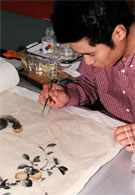
Miyata Takao learned to use alkaline hydrogen peroxide to reduce foxing in a Japanese painting on paper during his visit in 2006.
Visiting Professionals from Japan
Japanese painting conservators are invited for short-term study visits in the EAPCS, typically during the summer, for periods of several weeks to three months. Participants are encouraged to interact with members of the Freer and Sackler Galleries, various Western conservation centers, and other East Asian painting conservation studios in the United States.
Since 2004, five Japanese painting conservators have been chosen for their potential to benefit from exposure to Western conservation techniques and for their abilities to exchange ideas, build relationships, and share their experiences with other Japanese colleagues.
Workshops and Lectures on the Materials and Methods of Japanese Painting and Conservation

Okawa Atsushi, former researcher for the Kochi Prefectural Paper Industry and Technology Center, leads the "East Asian Paper Fiber Identification" workshop in 2005.
The EAPCS staff facilitated the first technical workshop, "East Asian Paper Fiber Identification," in 2005 and another four-day workshop, "Traditional Japanese Gold Decorating Techniques Used in Japanese Screen and Scroll Mounting," in 2007. More recent lectures have covered topics including fiber analysis of traditional Japanese papers, historic Silk and Traditional Weaving Methods for Reproducing Brocade fabrics and alternative materials, and types of roller clamps for storing rolled formats. Information and photos from these proceedings are available here.
Please see our calendar of future events.
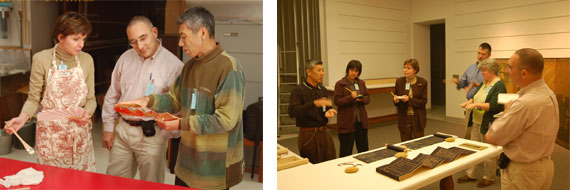
Visiting conservators and art historians examine paintings from the Freer collection as they exchange insights into the traditional techniques and art-historical implications of the use of gold in Japanese painting.
Workshops and Lectures on the Care and Handling of East Asian Scrolls and Screens
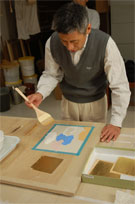
Wakiya Sukesaku demonstrates a gold leaf application technique over a ground of gofun during the "Traditional Japanese Gold Decorating Techniques" workshop in 2007.
These educational sessions generally consist of a half-day to two-day program that provides hands-on practice of safe handling procedures for scrolls and screens, guidelines for safe storage and display of collections, or basic conservation and maintenance issues. Presentations about the physical nature of East Asian paintings, mounting formats, and their methods and materials are also offered. These lectures and workshops can be conducted at the Freer Gallery or in other museums with Asian collections, as well as in educational institutions with programs in Asian art history. Versions of these workshops are also given at the Freer and Sackler Galleries for staff, fellows, and interns each year.
For educational materials related to the care of East Asian painting collections, please see our archive.

Andrew Hare leads a gallery talk for visiting art historians and students about the materials, methods, and aesthetics of Japanese painting and mounting.
Lectures and workshops on the physical nature and preservation of Japanese paintings to augment university courses and educational programs in East Asian art history
In cooperation with Asian art history faculty at U.S. colleges and universities, "Care and Handling" workshops have been developed to acquaint art history students with the practical concerns of handling, storage, and display of East Asian paintings. These workshops are offered onsite as part of the art history coursework or can be coordinated with study visits to the Freer and Sackler Galleries.
Presentations about the physical nature of East Asian paintings, mounting formats, and their methods and materials are also offered. These lectures focus on specific aspects of Japanese paintings, such as characteristics of traditional pigments and painting supports, aesthetics and function of mounting formats, and the effects of conservation on the appearance of the image.
For information about the Hirayama Program, please e-mail dcsr@si.edu or call +1 (202) 633-0385
For educational materials related to the materials, methods, and care of East Asian painting collections, please see our online resources.
Conservation
OverviewObjects Conservation
Paper Conservation
Exhibitions Conservation
East Asian Painting Conservation Studio
More About the Department
Scientific Research
Scientific research at the Freer and Sackler Galleries is primarily focused on the physical nature of artworks from Asian cultures. More info »
Staff Publications
Publication is an integral part of our research program. Click below to view lists of published works by past and present members of the department:
Online Resources
Safe Handling Practice for Chinese and Japanese Scrolls and Screens
Making East Asian Scroll Storage Boxes (PDF)
Making a Mylar Preservation Roller (PDF)
Making an Ethafoam Preservation Roller (PDF)
Making a Japanese Karibari Drying Board
Report: My Training Here and Abroad - Grace Jan
Conservation of a Nara-period handscroll
Asian Art Connections (PDF)